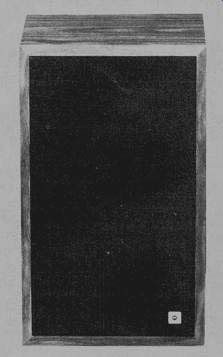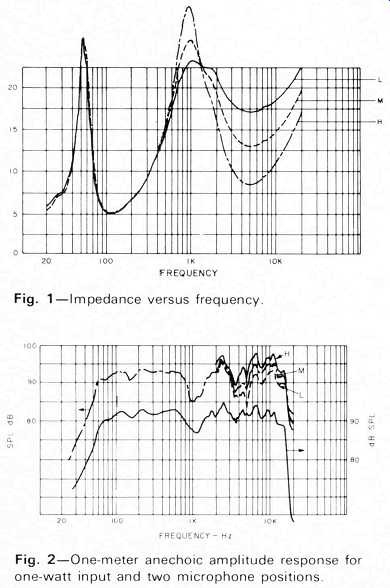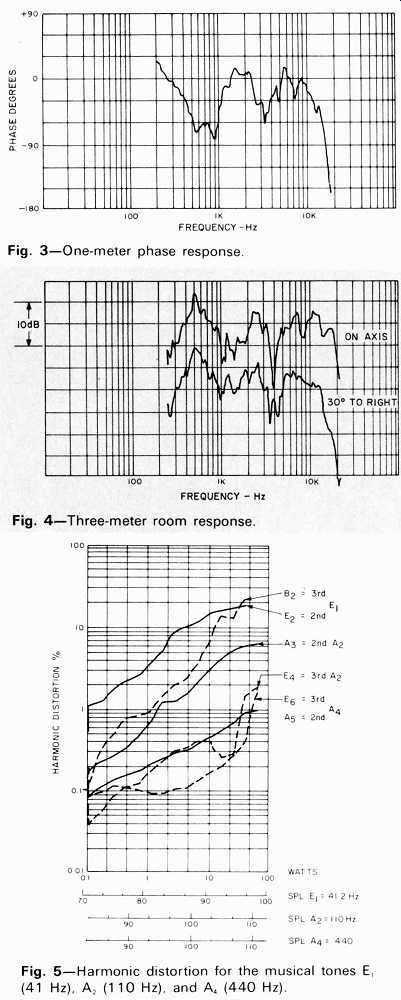
MANUFACTURER'S SPECIFICATIONS
System Type: Acoustic Suspension.
Drivers: One 10-in. woofer with 1 1/2-in. voice coil and 2-1b. magnet structure; one 1 1/2-in.
Mylar dome tweeter with 1-lb. Alnico magnet structure.
Crossover: RLC network; tweeter level control has 6 dB range.
Nominal Impedance: 8 ohms.
Dimensions: 15 in. W x 10 in. D x 25 in. H.
Weight: 40 lbs. Price: $122.00.
One of the newest additions to the speaker line of the Knoxville, Tenn., based Applied Physics Laboratory is the APL-101. While the modest size of this speaker allows ready use as a bookshelf unit, the enclosure is quite sturdily built and weighs in at a healthy 40 lbs. A 10-in., high-compliance woofer, which is acoustically loaded by the sealed enclosure, handles the low bass frequencies and the midband up to around 1 kHz. The upper midrange and high frequencies are reproduced by a 1 1/2-in. hemispherical dome tweeter.
The cabinet is finished on four sides with a wood-grain vinyl, and the rear of the cabinet is stained a matching color. The cloth grille is attached to a solid frame, and the whole assembly then closely fits into the front shadow frame in such a way as to obviate the need for fastening devices.
Connection of hookup wiring to the speaker is made through a terminal strip contained in a recessed cavity on the rear of the cabinet. This is a screw-terminal type of mounting which will take either spade lugs or bare wire. The screw terminals are rather close together, and no mechanical barrier is provided between the exposed metal of the terminals. If stranded wire is used for hookup, care should be exercised to prevent an amplifier-damaging short circuit.
The speaker terminals are not identified with polarity marks, and on the units tested by AUDIO, the rightmost terminal, adjacent to the tweeter level control, is the positive terminal. While polarity can easily be determined, the inclusion of this information would be helpful to those who wish to use the APL-101 as a quadraphonic add-on speaker set, although this is not of as great a consequence if these are the only speakers in the system.
The tweeter level control is a three-position switch with adjustments made by rotating a fluted plastic shaft. The letters "H, M, and L" above the shaft signify high, medium, and low tweeter levels, and a counterclockwise shaft rotation increases tweeter level. The plastic shaft extends beyond the plane of the cabinet so that a vigorous push against a hard wall while mounting or cleaning could result in a broken shaft. This re viewer hopes that Applied Physics Laboratory will choose to improve the engineering of the rear panel control and connection strip so as to minimize problems of setup for the hasty or inexperienced user.
There were no instructions or recommendations included with the APL-101's which could assist a non-technical buyer in setup or give information about precautions to be observed. Again, this reviewer feels that such information about appropriate hookup configuration is worthwhile in that it provides assistance to enhance ultimate music enjoyment, as well as warning the user against possible abuses which might void the warranty.
The APL-101 is provided with an unconditional five-year warranty against defects in either materials or workmanship. In addition, these speakers carry a most unusual lifetime warranty to the original owner, which goes into effect when the warranty card is returned to the factory.
Technical Measurements
The impedance as a function of frequency for each of the three tweeter level positions is shown in Fig. 1. The low frequency peak occurs at 55 Hz with the higher frequency peak, due to the tweeter, at 1 kHz. The minimum impedance of 5 ohms occurs at slightly over 100 Hz. As a consequence of its relatively low impedance, this speaker should not be paralleled for drive from most amplifiers, such as might be done for adding a speaker in a remote location.
Figure 2 shows the one-meter anechoic response for amplitude with a drive equivalent to one watt into an 8-ohm load. Two sets of curves are shown. The upper curves, with one-watt drive SPL readings on the left scale, refer to a measurement made exactly on the geometric center line of the enclosure. This is our standard physical configuration, and the measurement is made for the three positions of the tweeter control. The effect of the tweeter control amounts to approximately 2 dB response difference above 3 kHz.
In many cases, a much smoother anechoic response can occur for selected positions of the geometric axis, and the lower curve, with SPL readings on the right, shows such a case for the APL-101. In this case the microphone was moved five inches so as to lie one meter directly in front of the woofer. This curve was taken with the tweeter control in its medium position. In all cases, the APL-101 ranks as a relatively efficient speaker when compared with most other speakers in its price range, and good sound level can be expected from a 25-watt amplifier.
Figure 3 is the one-meter phase frequency response corresponding to the geometric center amplitude response marked "M" in Fig. 2. Both the woofer and tweeter are in phase, which means that a positive-going voltage produces a corresponding pressure increase at the microphone. The response is non-minimum phase above 10 kHz for this measurement. The hemispherical dome tweeter has the unusual property of a constant 90 degree phase lag at close measurement. As the microphone is moved back from the tweeter, the phase lag diminishes. As can be seen, there is still a residual lag on the order of 15 degrees even at one meter. The phase break below 1 kHz indicates the approximate acoustic crossover between tweeter and woofer.
Figure 4 shows the amplitude response due to the first 10 milliseconds of sound arrival in a room. The APL-101 was mounted flat against a wall with its geometric center one meter above a carpeted floor. The microphone was three meters away and one meter above the floor, simulating an average listening position. The response was measured directly in front of the speaker and in a 30-degree off-axis position corresponding to a left channel stereo position. The medium tweeter control level was used for both are displaced 10 dB for clarity of presentation. This measurement indicates a speaker sound that is suppressed in the portion of the midrange spectrum normally considered the "presence" range and with substantial reinforcement of the octave between A4 (440 Hz) and A5 (880 Hz). The off-axis effect is indicated as slightly down in the highs with an average drop off of about 1 dB per octave.
Figure 5 is the measured harmonic distortion for the musical tones E1 (41 Hz), A, (110 Hz), and A. (440 Hz). The relatively rapid increase of low bass distortion above an SPL of 90 dB suggests that the use of bass boost in a preamplifier should be discouraged when reproducing material with substantial bass demand, such as pedal notes on the organ. The tweeter was measured at 2 kHz and found to be quite clean, with second harmonic distortion rising smoothly from a low of 0.1 percent at 0.1 watt to a value of one percent at 10 watts. The 2 kHz third harmonic stayed well below 0.2 percent throughout this power range.

Fig. 1--Impedance versus frequency.
Fig. 2--One-meter anechoic amplitude response for one-watt input and two microphone positions.

Fig. 3--One-meter phase response.
Fig. 4--Three-meter room response.
Fig. 5--Harmonic distortion for the musical tones E1 (41 Hz), A, (110 Hz), and A4 (440 Hz).
Figure 6 is the measured intermodulation of A4 (440 Hz) by E, (41 Hz) when mixed in equal ratio. This intermodulation was mostly phase modulation with a small amount of amplitude modulation. During both the harmonic and intermodulation tests, it was noticed that the transducer gain, which is the ratio of output acoustic level to electrical drive level, decreased with increase in drive. At the 10-watt IM level, for example, the acoustic response at 440 Hz dropped 0.5 dB. Suppression increased to 1.5 dB at the highest level of this test. This was reproducible, and the effect is similar to dynamic compression, which might account for an observation made during the listening test.
This effect was also evident in the crescendo handling test, in which white noise, band limited to 20 kHz, is mixed at an average power level 20 dB above that of a pure tone. The total power level at which the tone is reduced 1 dB in level when the noise is added, is the limit we set for the ability of a speaker to handle random crescendos without affecting inner musical voices. The APL-101 suppressed 440 Hz by 1 dB with a peak speaker noise voltage of 25 volts. For an 8-ohm system, this translates to an 8-watt average noise level and a peak input just below 80 watts. This suppression occurs only with the woofer, since a 2-kHz tone showed no suppression even up to much higher levels. The technical conclusion of this measurement is that program material below 1 kHz will be partially dynamically compressed by the total energy in that range.
Figure 7 is the measured polar energy response for all components in the 20 Hz to 20 kHz frequency range. Some beaming is evident, and this reviewer recommends turning the speaker in toward the listening position for better stereo separation.

Fig. 6--Intermodulation of A, (440 Hz) by E, (41 Hz) mixed 1:1.
Fig. 7--Polar response
Fig. 8--Energy-time response one meter on axis.
Figure 8 is the measured time response one meter on axis. This measurement is the time equivalent of the on-axis frequency response of Figs. 2 and 3 and shows the time spread for the transient signal having the perfect 20 Hz to 20 kHz frequency spectrum used to generate Fig. 2. The equivalent positions of the front and rear of the cabinet are shown for comparison on this plot. The multiplicity of regularly spaced peaks following the initial sound arrival is similar to those to be expected from diffractive scatter from structures closely associated with the tweeter. The net energy remains 20 dB below the peak after one-half millisecond, so the sonic effect is probably not as prominent as this plot indicates.
Listening Test
For the listening test, the APL-101's were placed slightly over three meters apart as flat against a wall as possible above the floor. Both horizontal and vertical mounting positions were tried. Since the vertical mounting position gave the better stereo image, this was the position chosen for the majority of the listening.
The lowest registers are robust without sign of any resonance or hangover down to 50 Hz, as determined from listening to the Sessions test record made for use in such tests. On dynamic program material, the general impression this reviewer had was that of a mild midbass bump in response with the very high frequencies down a bit in level. In addition, it was this reviewer's opinion that the midrange lacked the strong punch demanded by contemporary music.
Even though the very lowest bass is down in level, classic organ sounds reasonably balanced without need for conventional equalization. Choral selections could be brought up to a respectable realistic spectral balance by treble boost, but too much boost led to a "spiffy" top end. Orchestral brass could not be equalized to this reviewer's satisfaction by conventional tone control equalization, and vocal and piano material was similarly suppressed in the midrange.
Basic stereo imagery was well balanced though dependent upon seating position when the angle of speaker separation was greater than about 60 degrees.
The listening test, conducted prior to technical measurements, disclosed an unusual sonic effect, jotted down in notes as an "impression of dynamic compression," and which was obvious only when rapid comparisons were made be tween the APL101's and a test speaker playing the same material. The observation was made regarding the reproduction of material including Carly Simon's No Secrets, Elecktra EQ-5049. To put this effect in perspective, the sound levels used for this test were definitely well above normal apartment listening levels, but within the speaker's safe-operating area.
The APL-101 can be recommended as a primary speaker system in an apartment or other situation where a much larger system would be inappropriate and the music is not intended to be the ear-blasting variety. These speakers can in addition be recommended as a good four-channel add-on to augment existing good-quality primary speaker systems.
-Richard C. Heyser.
(Audio magazine, Jun. 1974)
Also see:
Allison Acoustics Allison: One Speaker System (Equip. Profile, Apr. 1976)
= = = =